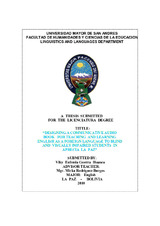Mostrar el registro sencillo del ítem
Designing a communicative audio book for teaching and learning english as a foreign languaje to blind and visually impaired students in aprecia La Paz
| dc.contributor.author | Guerra Huanca, Viky Eufemia | |
| dc.contributor.author | Rodriguez Burgos, Mirta (Tutora) | |
| dc.date.accessioned | 2018-07-08T16:20:00Z | |
| dc.date.available | 2018-07-08T16:20:00Z | |
| dc.date.issued | 2010 | |
| dc.identifier.citation | Lenguas Extranjeras | es_ES |
| dc.identifier.uri | http://repositorio.umsa.bo/xmlui/handle/123456789/16874 | |
| dc.description.abstract | As an effort to provide equal educational rights to all students in Bolivia the main aim of the present study is to develop a communicative English audio book to fulfil somehow the special educational needs that the blind and visually impaired students in Bolivia have for learning English as a foreign language. Having this aim in mind, the present investigation is divided into three main parts. The first part presents a diagnosis of the situation of teaching and learning English as a foreign language in three institutions for blind and visually impaired students (7 - 13 years old) in Bolivia; “Aprecia” (La Paz), “Manuela Gandarillas” (Cochabamba), and “Maria Antonieta Suarez” (Oruro). This diagnosis was carried out in order to know the special educational needs that the blind and visually impaired students have in relation to learning English. In the second part, the communicative approach theory is analysed, as well as the special educational needs of the visually impaired population. Based on all this revision the communicative English audio book was developed. Finally, the third part of the investigation presents the application of the proposed material to our sample, the blind and visually impaired students of “Aprecia” La Paz. Therefore, in chapter I, we attempt to give a general background description of the research. Thus, in this first chapter the thesis justification, the statement of the problem, delimitation of the research, objectives, hypothesis, and identification of variables are described. In chapter II, the literature related to the topic of the investigation is reviewed in order to support the research we are endeavoured in this paper. Chapter III presents the methodology of the investigation, the population that was taken into account as well as the sampling. In chapter IV, we give a description of the instruments used in the research, we present and interpret the data collected from questionnaires that helped us to know the special educational needs that the blind and visually impaired students had for learning English as a foreign language. Afterwards, the application of the proposed audio material to the students of Aprecia La Paz. Our chapter V, presents the preliminary results obtained from this application aside from the demonstration of the hypothesis posed in chapter I. Finally, chapter VI, presents the general conclusions, suggestions and recommendations regarding the present investigation. It is hoped that the present study will be useful not only for blind and visually impaired students but also for anyone who wants to learn English using the proposed material (audio books) or want to develop listening comprehension in English. Also, we want to encourage teachers to modify and/or design materials that will help them to work more productively when they deal with these groups of students. | es_ES |
| dc.language.iso | en | es_ES |
| dc.publisher | Universidad Mayor de San Andrés. Facultad de Humanidades y Ciencias de la Educación. Carrera de Lingüística e Idiomas. | es_ES |
| dc.subject | EDUCACION ESPECIAL | es_ES |
| dc.subject | EDUCACION DE NIÑOS | es_ES |
| dc.subject | CEGUERA | es_ES |
| dc.subject | INGLES - ENSEÑANZA | es_ES |
| dc.title | Designing a communicative audio book for teaching and learning english as a foreign languaje to blind and visually impaired students in aprecia La Paz | es_ES |
| dc.type | Thesis | es_ES |

